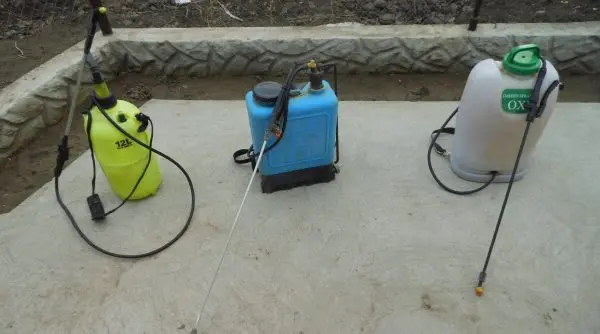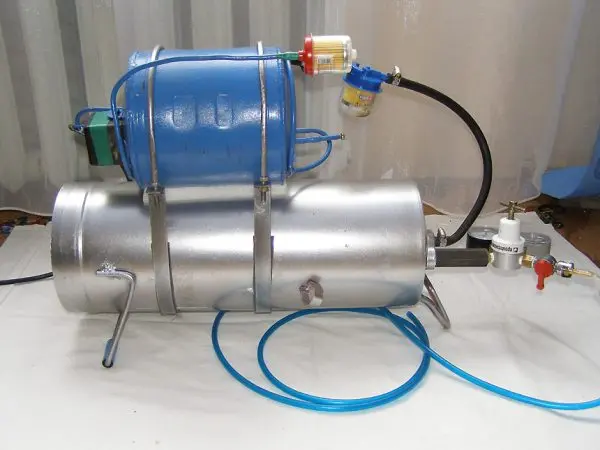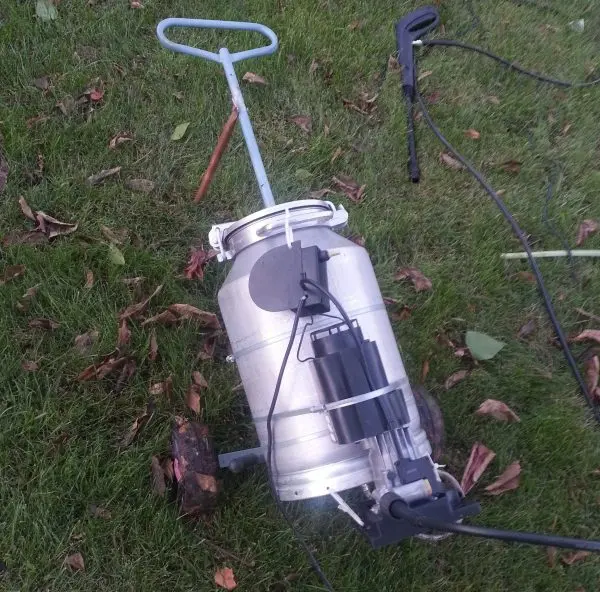Contents
Summer residents who are engaged in growing plants on their plots know how important it is to properly and timely care for plantings, whether it be trees, bushes or flowers. For effective care, every amateur gardener or gardener has a garden sprayer. Often gardeners-inventors make a sprayer with their own hands. It should be noted that it is not so difficult to design a homemade sprayer on your own, providing good care for all plants and protecting yourself from frequent machine repairs.
Device description
The main task of a garden sprayer is to effectively spray liquid (chemicals, fertilizers, stimulants, etc.) onto plants. The liquid applied in this way adheres perfectly to the plantings and exhibits its protective properties for a long time. Spraying is a necessary measure to protect bushes and fruit trees from diseases and pests (caterpillars, aphids, mites, etc.). In order for the processing process to proceed correctly, it is worth using special equipment – a garden sprayer.

All devices for this purpose can be divided into groups according to the principle of operation (from elementary manual to self-propelled). There are the following types:
- Manual sprayer, which is a plastic tank with a lid with a built-in pump pump. The pump creates the required pressure in the tank, then you can spray the liquid by pressing the lever on the handle. Units of this type are produced with a tank volume of 0,5 to 2 liters. It is ideal for spraying seedlings and other small-scale plantings.
- The pump sprayer is designed to spray a large number of plants. The volume of the tank is 3-12 liters. It must be worn on the shoulder with a special belt. There is also a pump on the cover, and from the body there is a hose (1-1,5 meters) with a special handle, a rod and a nozzle. Today pump-action garden sprayers are one of the most demanded. This is a great option for processing areas up to 30 acres.
- Hand knapsack sprayer – here the pressure is generated in the pump. Devices of this type are convenient because they can be carried behind the back, like a backpack. When processing plantations with this unit, you need to build up pressure with one hand, and hold the bar with a sprayer with the other, which is not very convenient and rather tedious.

- The battery knapsack sprayer is an improved model of the previous one. Its main advantage is that the pressure is generated by means of an electric drive from the storage battery. This mechanism greatly facilitates the process of processing plants and speeds up the process. Electric garden sprayers, due to their efficiency and productivity, are suitable for small private gardens and vegetable gardens, and for mini-farms.
- It is advisable to use a gasoline motor sprayer for work on large areas. The volume of the container for liquid here varies in the range of 12-20 liters. Sprayers of this type are divided into two types: knapsack, which is worn behind the back; wheeled, which can be freely moved around the garden.
All of the above units can be easily bought in markets or specialized stores, as well as ordered via the Internet. But you can do it yourself by making the device yourself from available materials. Perhaps this method will be the most correct, since a sprayer for the garden and vegetable garden made with your own hands can be easily adjusted to suit your needs and not worry about repairs in the event of any breakdown.

Video Mounted Garden Sprayer
Video on the use of a mounted self-propelled sprayer, by attaching it to a tractor structure.
What materials will be required
Many gardeners and gardeners use homemade products for spraying green spaces on their plots. You don’t have to be an engineer or inventor to make a garden sprayer – you just need to be smart. For work in the garden or greenhouse, you can use a regular broom, which will cope with the role of a sprayer. This is a cheap and easy way, but not very practical, as chemicals are wasted in the process.
To process a small number of bushes or seedlings, you can make an excellent manual sprayer from a windshield wiper container. Before use, you just need to wash the container well to clean it of unwanted elements. If you plan to create a more advanced garden sprayer, for example, an electric one, then you will need quite complex and serious parts: a tank, a pump, a check valve, a reinforced hose, a spray bar, a push-button switch, a stranded wire, etc. If you wish, you can even do self-propelled vehicle, but for this you already need to use equipment.

How to make yourself
Let’s take a look at how you can design a cordless sprayer. To make it, you need to take a tank – an old pump sprayer with a broken pump that cannot be repaired is perfect. In this case, it is extremely important that there is a sealed tank, a working rod and an air valve.
You will also need a battery (12V) and a car compressor. A hole must be drilled in the container and a car nipple inserted to which the compressor is connected. To seal the hole for the washers, you can use a rubber gasket or blow out with sealant. Then the compressor must be connected to the battery.

Due to the high pressure in the tank, the spray is very fine. The required pressure is pumped up, and its excess exits through the valve. The undeniable advantage of a self-designed battery sprayer is the ability to repair and replace any element. When working with any sprayer, it is worth remembering to follow the safety rules: protective clothing, use gloves, a respirator, a headgear. At the end of the work, the device should be disassembled and thoroughly rinsed with water, then dried and reassembled.
Video “Making a homemade sprayer”
Video instruction for making a garden sprayer from an unusable vacuum cleaner.
Author: Svetlana Galitsina
Loading…









